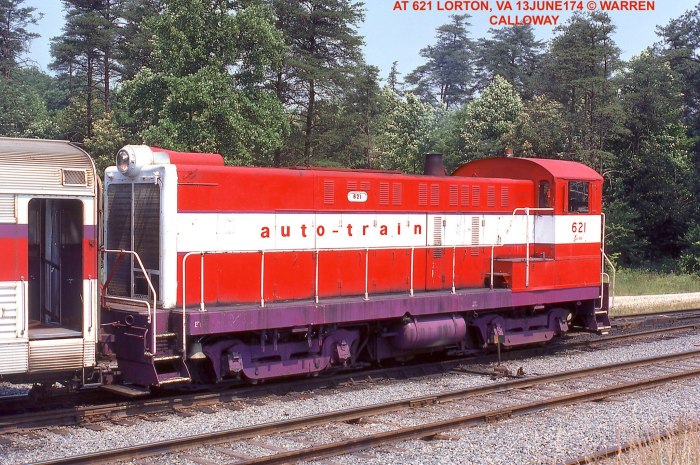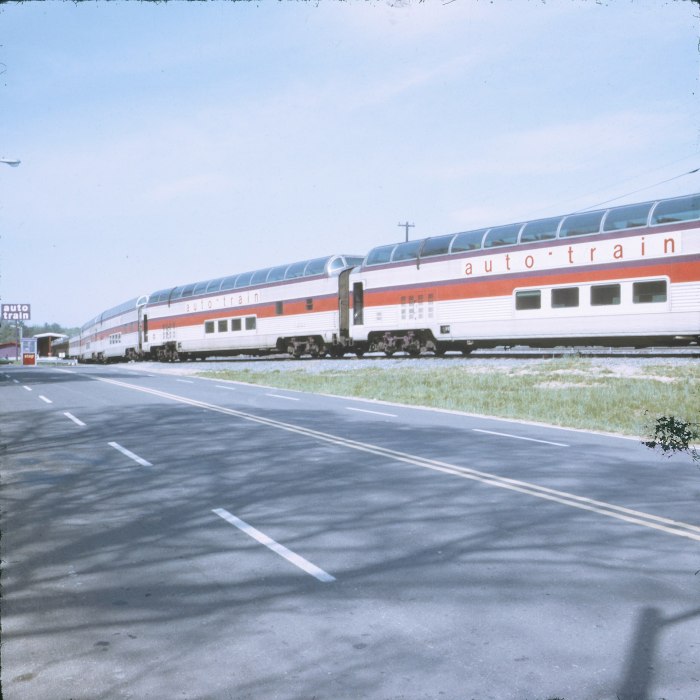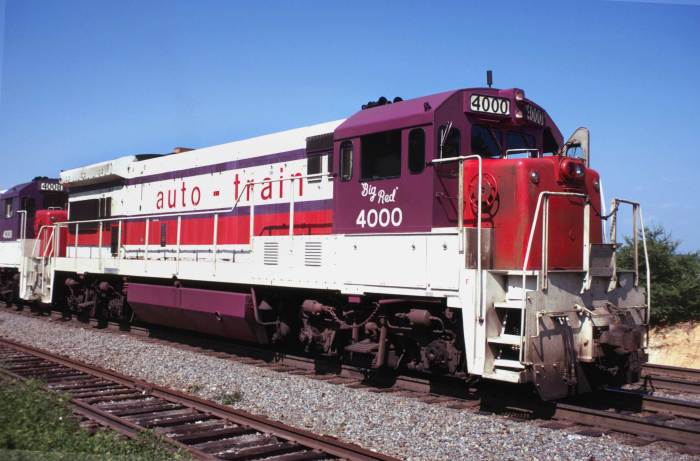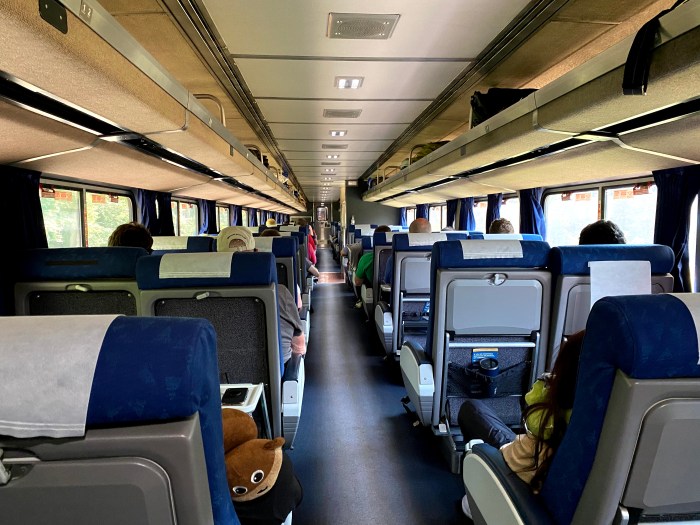Embark on a captivating journey into the realm of autotrain, a transformative mode of transportation that seamlessly blends the convenience of rail travel with the flexibility of personal vehicles. From its humble beginnings to its cutting-edge advancements, autotrain has played a pivotal role in shaping the transportation landscape.
Autotrain services encompass a diverse spectrum of options, ranging from passenger rail and freight rail to specialized transportation solutions. Each type offers unique advantages, catering to specific transportation needs and providing unparalleled efficiency.
Definition and Overview

Autotrain is a unique transportation service that combines rail and road travel, offering a convenient and efficient way to transport vehicles over long distances. It operates on dedicated rail lines, allowing customers to load their vehicles onto specialized railcars and travel alongside them in comfortable passenger cars.
Autotrain is particularly advantageous for individuals or families traveling with vehicles, eliminating the need for long and potentially tiring road trips. It also provides a cost-effective alternative to shipping vehicles separately, as the cost of transporting a vehicle on Autotrain is typically lower than the cost of shipping it via a commercial carrier.
If you’re planning an autotrain trip, remember to pack for the beach! Check out our beach holiday packing list for everything you need to make your autotrain journey and beach holiday a success.
Benefits of Autotrain
- Convenience: Autotrain eliminates the need for extended driving, providing a more relaxing and enjoyable travel experience.
- Cost-effectiveness: It offers a cost-effective alternative to shipping vehicles separately, especially for long-distance travel.
- Safety: Autotrain ensures the safe and secure transportation of vehicles, minimizing the risk of damage or theft during transit.
- Time-saving: By eliminating the need for driving, Autotrain saves valuable time that can be spent on other activities or relaxation.
Historical Evolution

Autotrain emerged as a revolutionary concept in the transportation industry, and its evolution over the years has been marked by significant milestones and advancements.
Inception and Early Years, Autotrain
Autotrain was conceived in the 1960s by Eugene K. Garfield, who envisioned a service that would allow travelers to transport their vehicles along with them on a train. The first Autotrain service commenced in 1971, operating between Lorton, Virginia, and Sanford, Florida. The initial trains consisted of modified passenger cars that could accommodate up to 180 vehicles.
Autotrain is a unique and convenient way to travel to and from Florida. With its spacious seating and comfortable sleeping accommodations, autotrain makes it easy to relax and enjoy the journey. And with its convenient stops in Orlando and Sanford, autotrain is the perfect way to get to your next vacation destination.
If you’re looking for a relaxing and stress-free way to travel to the amalfi coast italy , autotrain is the perfect option. You can sit back, relax, and enjoy the scenery while autotrain takes you to your destination.
Expansion and Innovations
In the 1980s, Autotrain underwent significant expansion and innovation. The service was extended to additional destinations, including Chicago, Illinois, and Miami, Florida. The introduction of bi-level rail cars increased the capacity of the trains, allowing them to carry up to 360 vehicles.
Amtrak Acquisition and Modernization
In 1983, Amtrak acquired Autotrain, bringing the service under the umbrella of the national passenger railroad system. Under Amtrak’s ownership, Autotrain continued to modernize its operations, introducing new amenities and technologies. In the 1990s, the trains were equipped with advanced safety systems, and the reservation process was computerized.
Present-Day Advancements
Today, Autotrain remains a popular and convenient transportation option for travelers. The service continues to evolve, with the introduction of new features such as online booking and mobile ticketing. Autotrain’s commitment to sustainability has led to the use of energy-efficient locomotives and the implementation of eco-friendly practices.
Types of Autotrain Services
Autotrain services encompass a range of options tailored to meet diverse transportation needs. These services can be broadly categorized into three main types: passenger rail, freight rail, and specialized transportation.
Each type of service offers unique features and benefits, catering to specific requirements and preferences. Understanding the distinctions between these services is crucial for selecting the most suitable option for your auto transportation needs.
Passenger Rail
- Designed for individuals and families traveling with their vehicles.
- Offers comfortable seating and sleeping accommodations for passengers.
- Vehicles are typically loaded onto enclosed railcars for secure transportation.
- Provides a convenient and time-saving alternative to driving long distances.
Freight Rail
- Primarily used for transporting large quantities of vehicles, such as those destined for dealerships or auctions.
- Vehicles are typically loaded onto open railcars or enclosed railcars, depending on the level of protection required.
- Offers a cost-effective option for bulk transportation of vehicles.
- Requires coordination with a freight forwarding company or vehicle shipping broker.
Specialized Transportation
- Tailored to specific vehicle transportation needs, such as classic car transport, luxury vehicle transport, or oversized vehicle transport.
- Employs specialized equipment and experienced drivers to ensure safe and secure handling of vehicles.
- Provides door-to-door service for added convenience.
- Typically comes at a higher cost compared to other autotrain services.
Operational Aspects

Autotrain services involve a seamless and efficient operational process that ensures the safe and timely transportation of both passengers and vehicles. This process encompasses meticulous scheduling, loading, and unloading procedures, supported by advanced technology and infrastructure.
Scheduling
Autotrain schedules are meticulously planned to optimize efficiency and cater to passenger convenience. Timetables are carefully designed to align with peak travel periods and ensure optimal utilization of the trains. Advance reservations are typically required to secure a spot on the train, ensuring a smooth and hassle-free experience for passengers.
Loading
The loading process is meticulously orchestrated to ensure the safe and secure placement of vehicles onto the train. Passengers drive their vehicles onto designated loading ramps, where trained personnel guide them into designated spaces within the train’s auto-carrier cars. These cars are specially designed to accommodate various vehicle sizes and types, ensuring stability and protection during transit.
Unloading
Upon arrival at the destination terminal, the unloading process is executed with the same precision and care as the loading process. Passengers disembark the train, while trained personnel carefully guide the vehicles off the auto-carrier cars and onto designated unloading ramps. This systematic approach ensures the smooth and efficient retrieval of vehicles by passengers.
Autotrain is a convenient and scenic way to travel between the East Coast and Florida. It’s a great option for those who want to avoid the hassles of driving or flying. The train also offers a variety of amenities, including comfortable seating, dining cars, and a lounge car.
Once you arrive in Florida, you can easily connect to adler planetarium and other popular attractions. From there, you can continue your journey by autotrain or explore the Sunshine State at your own pace.
Safety and Regulations
Autotrain operations are subject to stringent safety measures and regulations to ensure the well-being of passengers, vehicles, and personnel. These regulations encompass industry standards and best practices.
Industry Standards
- Federal Railroad Administration (FRA): Establishes and enforces safety regulations for all railroads operating in the United States, including Autotrain.
- Association of American Railroads (AAR): Develops and promotes safety standards for the rail industry, including guidelines for Autotrain operations.
- American Railway Engineering and Maintenance-of-Way Association (AREMA): Provides technical recommendations and standards for railway infrastructure and operations, including Autotrain tracks and equipment.
Operational Safety Measures
Autotrain implements comprehensive safety measures to minimize risks during operations:
- Thorough Vehicle Inspections: Vehicles are meticulously inspected before boarding and during transport to ensure they are in good condition.
- Secure Vehicle Loading: Vehicles are securely tied down and positioned within designated areas to prevent movement during transit.
- Trained Personnel: All Autotrain personnel undergo rigorous training to ensure they are well-versed in safety protocols and emergency procedures.
- Advanced Communication Systems: Autotrain uses state-of-the-art communication systems to facilitate real-time monitoring and coordination during operations.
Environmental Impact

Autotrain services have an environmental impact due to fuel consumption, emissions, and noise pollution. However, autotrain providers are adopting sustainable practices and technologies to minimize this impact.
Fuel Consumption and Emissions
Autotrains consume a significant amount of fuel, which contributes to greenhouse gas emissions. To reduce fuel consumption, some autotrain providers have implemented measures such as using more fuel-efficient locomotives and optimizing train schedules. Additionally, some providers are exploring the use of alternative fuels, such as biodiesel or electricity, to further reduce emissions.
Noise Pollution
Autotrains can generate noise pollution, which can affect nearby communities. To mitigate this impact, autotrain providers are investing in noise-reduction technologies, such as installing sound barriers and using quieter locomotives. Additionally, some providers are exploring the use of electric locomotives, which produce less noise than diesel locomotives.
Sustainable Practices
In addition to the measures mentioned above, autotrain providers are implementing various sustainable practices to reduce their environmental impact. These practices include:
- Using renewable energy sources, such as solar and wind power, to power train operations.
- Recycling and composting waste generated on trains.
- Educating passengers on sustainable travel practices.
By adopting these sustainable practices and technologies, autotrain providers are working to minimize their environmental impact and contribute to a more sustainable transportation system.
Economic Impact
Autotrain services have a significant economic impact on local economies and the transportation industry as a whole. By providing a convenient and affordable way to transport both passengers and vehicles, Autotrain has contributed to job creation, tourism, and infrastructure development.
Job Creation
- Autotrain directly employs thousands of people in various roles, including train crews, station staff, and maintenance personnel.
- Indirectly, Autotrain also creates jobs in related industries, such as hospitality, food service, and retail.
Tourism
- Autotrain makes it easier for tourists to travel with their vehicles, allowing them to explore destinations that are not easily accessible by other means of transportation.
- This increased tourism generates revenue for local businesses, such as hotels, restaurants, and attractions.
Infrastructure Development
- Autotrain requires specialized infrastructure, including rail lines, loading ramps, and terminals.
- The development and maintenance of this infrastructure creates jobs and stimulates economic growth in the surrounding areas.
Future Trends and Innovations
The Autotrain industry is poised for significant growth and innovation in the coming years. Emerging trends and technological advancements are expected to shape the future of Autotrain services, enhancing convenience, efficiency, and sustainability.
One key trend is the integration of advanced technologies, such as artificial intelligence (AI) and the Internet of Things (IoT). AI-powered systems can optimize train schedules, predict demand, and provide personalized travel experiences. IoT sensors can monitor train conditions, track vehicle location, and improve safety.
Technological Advancements
- Autonomous Train Operation: Automation of train operations can enhance safety, reduce labor costs, and improve efficiency.
- High-Speed Rail: Advanced rail technologies, such as maglev trains, can significantly reduce travel times and expand the reach of Autotrain services.
- Digital Ticketing and Reservations: Online and mobile ticketing platforms simplify the booking process and provide real-time updates.
Service Enhancements
- Personalized Travel Experiences: AI-powered systems can tailor travel recommendations and provide personalized amenities based on passenger preferences.
- Enhanced Comfort and Convenience: Modern Autotrain carriages offer amenities such as Wi-Fi, charging stations, and entertainment systems.
- Intermodal Connectivity: Partnerships with other transportation modes, such as ride-sharing services and public transit, can provide seamless travel options.
Last Word: Autotrain

As autotrain continues to evolve, it holds immense promise for the future of transportation. With emerging technologies and innovative service enhancements on the horizon, autotrain is poised to revolutionize the way we travel, ship goods, and connect communities.
FAQ Corner
What are the benefits of using autotrain services?
Autotrain services offer numerous benefits, including convenience, time savings, cost-effectiveness, and reduced environmental impact.
How does autotrain compare to traditional rail travel?
Autotrain combines the comfort and convenience of rail travel with the flexibility of bringing your own vehicle, allowing you to explore destinations at your own pace.
What safety measures are in place for autotrain operations?
Autotrain operations adhere to stringent safety regulations, including secure vehicle loading and unloading procedures, regular inspections, and comprehensive training for personnel.